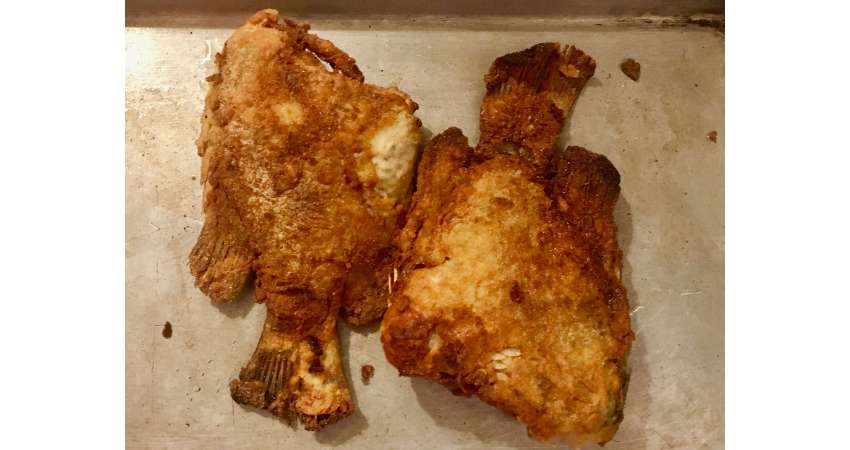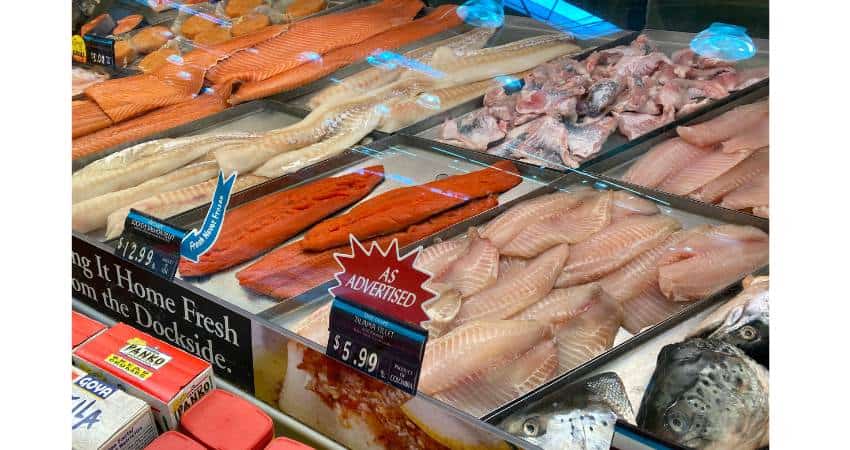Rock Bass vs Warmouth – Are They The Same? Let’s Compare
Rock bass and warmouth share many similarities. For this reason many people ask if they’re the same or different. Therefore, let’s answer, are warmouth and rock bass the same?
Warmouth and rock bass are not the same, they are different species although they are from the same family. Rock bass is the A. Rupestris species and warmouth is the L. gulosus species. Warmouth weigh slightly more than rock bass. Warmouth has a golden belly compared to the white belly of the rock bass.
This article will compare their tastes, textures, cooking methods, costs, mercury levels and whether one can substitute for the other in recipes. In addition, I’ll do a side-by-side comparison of their habitats, appearance and compare their nutritional value.
Rock Bass vs Warmouth: Habitats, Size, Weight and Appearance
How can you tell the difference between the two?
The best way to tell the difference between a rock bass and a warmouth is to check the markings on their heads. Warmouth have reddish brown lateral streaks around their eyes and gill flaps. Instead of lateral streaks, rock bass have dark tear drop shaped markings under their eyes. A warmouth anal fin has 3 spines while rock bass have 5-7.
Other ways to tell the difference:
- Rock bass have multiple black spots forming lateral lines down the body. Warmouth sides have brown blotches and no lateral lines.
- Rock bass have red or orange eyes. Warmouth have dark eyes except for males who have red eyes while breeding.
- Rock bass have a silvery white belly. Warmouth have a golden colored belly.
- Male warmouths have an orange spot at the base of their dorsal fin. Rock bass don’t have a colored spot at the base of their dorsal fin.
Rock Bass and Warmouth Scientific Classifications, Families, Species
Rock bass are from:
- Family: Centrarchidae
- Genus: Ambloplites
- Species: A. rupestris
- Common nicknames: Red eye, panfish, rock perch, goggle eye.
Warmouth are from:
- Family: Centrarchidae
- Genus: Lepomis
- Species: L. gulosus
- Common nicknames: Red eye, goggle eye, red eyed bream, strawberry perch.
Habitats
RockBass
- They are native to North America and can be found from Canada down to Florida and west to Texas. They are mostly found in the eastern and central United States.
- While bass fishing they can be found in streams, ponds, lakes and rivers.
- They prefer rocky shorelines and vegetation areas. They can be found under docks and near swimming areas.
Warmouth
- They are native to North America and the eastern United States. They can be found from southern Canada down to the Gulf of Mexico and west to Texas. They are mostly found in the central and eastern United States.
- When fishing they can be found in streams, ponds, lakes and rivers.
- They prefer banks with rocks, weeds and around objects like logs or tree stumps.
Appearance
Colors
- Rock bass have an olive green to golden brown upper back and sides fading down to a silvery, white belly. They have black spots which form broken lateral stripes down the body. The eyes are red.
- They have the ability to change colors to match their surroundings for protection.
- Warmouth is dark olive near the upper back and the sides are mottled with brown patches and golden areas. The lower body and belly are a golden color. They have reddish brown lateral streaks around the eyes and gill flaps.
- Male warmouths may have red eyes when breeding. Males also have an orange spot at the base of the dorsal fin.
Dorsal Fins
- Rock bass has one dorsal fin with 10-13 spines and 11-13 rays.
- Warmouth has one dorsal fin with 10 spines and 11-13 soft rays.
Anal Fin
- The rock bass anal fin has 5-7 spines followed by soft rays.
- The warmouth anal fin has 3 spines followed by soft rays.
Mouth
- Both mouths are large but doesn’t extend past the eye line. Also, their mouths doesn’t curve upward.
- Both have teeth on the tongue.
Distinguishing Marks
- Rock bass has red eyes and rows of dark spots forming lateral lines down the body. They have a dark tear drop below their eye.
- Warmouth’s lateral streaks are reddish-brown around their head, eyes and gill flaps. Males have an orange spot at the base of their dorsal fin.
Male warmouth has red eyes when breeding.
Body Shape
- Both bodies are flat and slightly elongated.
- They have similar compressed bodies.
Size and Weight
- Rock bass average 6-10″ long and weighs about 1 pound.
- Warmouth average 4-10″ long and can weigh 1-2 pounds.
Warmouth is actually somewhat larger than the actual rock bass. They are both considered small.
Lifespan
- Rock bass lives up to 8-10 years.
- Warmouth lives up to 8 years.
Diet
Rock bass likes to consume the following:
- Insects
- Worms
- Smaller fish
- Minnows
- Small crustaceans
Warmouth likes to consume the following:
- Insects
- Insect larvae
- Shrimp
- Small crustaceans
- Small fish
- Crayfish
In a recent article I compared crappie. Find out how these similar sunfish compared in my comparison article.
Fishing
Rock bass fishing won’t win many popularity contests amongst anglers. Despite their gamefish appeal, when fishing they are strangely appealing.
When bass fishing they can get caught with almost any angling method. Live bait works extremely well. Fishing bass within a few feet of the bank is best.
Tastes and Textures
One of the most important things people takes into consideration when choosing a fish is its taste. When comparing the two fish, warmouth vs rock bass, do they taste the same?
Rock bass and warmouth have a similar mild to sweet taste. Their flavor is not considered strong or fishy. Both have a firm texture and a little flakey.
Both warmouth and rock bass are good to eat and most people are pleased with the mild taste.
To conduct some original research, I polled many of my clients, readers and members of food groups I belong to. The following are the results of my poll which consisted of 25 people.
I asked which fish tasted better?
- 41% preferred the taste of rock bass.
- 32% preferred the taste of warmouth.
- 27% said they liked both fish the same.
To conduct more research I conducted my own taste test at home. When both became available to me they were cooked the same way. The results of my test were similar to the poll.
Bluegill is another sunfish. In my recent article find out which one tasted better in my poll of readers, Bluegill – What’s The Difference? We Compare.
The following video shows a catch and cook rock bass.
Substitutions
When preparing recipes for dinner it’s not always possible to locate the type of fish the recipe calls for. If you have only one fish or caught one while fishing, you may ask, can I substitute one for the other?
Rock bass and warmouth can substitute for each other due to their similar tastes and textures. Both species can be used in many of the same recipes and cooking methods. They both can be cooked by baking, broiling, steaming, grilling, deep frying and pan frying.
Rock bass substitutes:
- Bluegill
- White crappie
- Black crappie
- Pumpkinseed
- Green sunfish
- Lake herring
- Tilapia
- Pollock
Warmouth substitutes include the following:
- Rock bass
- Pumpkinseed
- Crappie
- Green sunfish
- Lake herring
- Pollock
- Bluegill
Find out how they compared to Largemouth bass. Largemouth bass is actually another sunfish. Check out my article here.

Costs
The costs for some seafood will vary depending on how the fish are caught and where they’re sold. When purchasing any fish, be sure to check the label to see if it is wild-caught or farm raised. Therefore, which fish is more expensive?
Rock bass and warmouth have a similar price. The average cost for both fillets are $19.43 per pound.
Their fillets are extremely difficult to find for sale. Bluegill, crappie or “sunfish” are easier to find online. Most people get the whole fish while fishing and then take them home to cook.
To conduct original research on prices, I checked online at Walleye Direct and found the following prices:
- Wild, bluegill fillets
- $25.36 per pound
- Wild, crappie fillets
- $22.00 per pound
Seafood Markets:
- Wild, sunfish fillets (does not specify which kind of sunfish)
- $18.00 per pound
Dixon Fisheries:
- Bluegill fillets
- $14.95 per pound
For stocking ponds, Pond King has the following price per live fish:
- Hybrid bluegill (green sunfish x bluegill) $0.75 per 3-4″ fish
- Bluegill – $0.75 per 3-4″ fish
- Black crappie – $1.00 per 3-4″ fish

Nutrition: Are Warmouth Bad?
Maybe it’s the name. Some people want to know are warmouth bad and is bass good? Warmouth and rock bass are excellent sources of protein, healthy fats, minerals and B vitamins. Both sunfish fish contain the following:
- Omega-3 fatty acids
- Niacin
- Folate
- Potassium
- Magnesium
- B6
- B12
- B5
- Thiamin
- Riboflavin
- Iron
- Selenium
- Calcium
- Zinc
((The Topeka Capital-Journal: Keto, Paleo or Atkins diet? Hunting, fishing can help trim your waistline in 2020))1
Is Bass Good?
They both provide a similar percentage of the same nutrients and are beneficial for health. Keep reading and find out how they benefit health followed by their mercury levels.
Find out which one is more similar to smallmouth bass than largemouth bass, although they’re all sunfish. Check out my comparison article here.
Rock Bass and Warmouth Health Benefits
Omega 3 Fatty Acids
The omega-3 fatty acids contained in warmouth and rock bass help keep arteries healthy and are considered heart healthy. The omega-3s may help with the following:
- Lowering triglycerides.
- Reduce inflammation.
- Reduce plaque buildup.
- Keeping bad cholesterol low.
- Keeping good cholesterol high.
- Help keep the heart rhythms more normal.
DHA and EPA, two of the fatty acids, are associated with lowering blood pressure and improving the health of blood vessels ((National Center for Biotechnology: Marine Omega-3 Supplementation and Cardiovascular Disease)).
Studies suggest omega-3s can help reduce joint pain and stiffness in people with rheumatoid arthritis.
They may also boost the effectiveness of anti-inflammatory drugs.

B Vitamins
The B vitamins provided include B1 (thiamin), B2 (riboflavin), B3 (niacin), B9 (folate) B6, B12 and B5. B vitamins help support the following:
- Digestion.
- Brain function.
- Energy levels.
- Red blood cells.
- Cardiovascular disease.
- Nerve function.
Potassium
Potassium helps the body get rid of excess sodium which helps reduce fluid build-up. These help keep systolic and diastolic blood pressure lower ((American Heart Association: How Potassium Can Help Control High Blood Pressure)).
The more potassium you consume, the more sodium your body will lose. Consuming too much sodium or not enough potassium throws off the delicate balance the kidneys need to remove the excess water2.
According to Harvard Health, a number of studies show a connection between low potassium levels and increased blood pressure3.
Calcium
Bass and warmouth provide approximately 85-90 mg of calcium per four ounces. Calcium is important for blood pressure and the heart.
Harvard Health reports calcium helps maintain blood pressure because it helps to control the relaxing and tightening of blood vessels4.
Calcium also helps the following:
- Build and maintain strong bones.
- Muscles need calcium to function properly.
- Improve nerve function.
If you have any questions about this article don’t hesitate to email us. You can find an email on our contact page.
As a Certified Health Coach many of my clients ask me about seafood. In addition to educating my Health Coaching clients about warmouth and rock bass, I have researched, purchased and consumed both fish for 20 years prior to, during and after writing this article.
Read Next – More Fish Articles!
Crappie vs Bluegill – What’s The Difference? Let’s Compare
Bluegill vs Redear Sunfish – Are They The Same? We Compare
Black Crappie vs White Crappie – What’s The Difference?
Bluegill vs Pumpkinseed – Are They The Same? Let’s Compare
Bluegill vs Redbreast Sunfish – What’s The Difference?
Bluegill vs Green Sunfish – What’s The Difference?
- Nutritiondata: Fish, sunfish, raw [↩]
- National Center for Biotechnology Information: The Effect of the Sodium to Potassium Ratio on Hypertension Prevalence: A Propensity Score Matching Approach [↩]
- Harvard Health: Potassium lowers blood pressure [↩]
- Harvard Health: Key minerals to help control blood pressure [↩]
